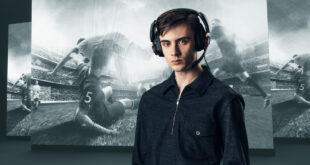[This feature was published in the September 2013 edition of Develop magazine, which is available through your browser and on iPad.]
Chanel Summers believes passionately that video games, and game audio in particular, should increasingly aspire to greater artistic goals.
“Over the past decade or two, we’ve taken huge evolutionary leaps forward when measured by quality of execution and advancements in technology,” says Summers, who stands as Syndicate 17 co-founder and adjunct professor at USC School of Cinematic Arts’ Interactive Media Division.
“But as in any art form, real innovation doesn’t come from technology, but from the creativity and experimentation of the artists who wield it – I believe video game audio has only just begun to scratch the surface of what’s possible artistically.”
THE ART OF THE MATTER
All well and good but what does that mean in practice – how do we know when we’ve produced ‘art’?
“The mark of superior sound design, like many art forms – painting, sculpture, theatre, cinema – is one that you don’t consciously notice,” offers Summers.
"It works on a person’s subconscious, playing with silence, subtlety and tension, manipulating the mood and drawing the player into the game world. It takes advantage of the basic elements of audio aesthetics and utilises devices such as ambiguity, juxtaposition, counter-functional sounds, and misdirection.”
Artistic audio, argues Summers, is audio that can be used to craft the story elements of a given game, and control the pacing of gameplay, supporting the narrative, eliciting and influencing emotion, creating mood, shaping perception and reinforcing how players experience game characters.
“However, sadly, in many titles, audio is purely functional simply facilitating gameplay, whilst potential emotional and psychological uses of sound that could lift the game’s audio to the level of ‘art’, are sacrificed in the name of ‘utility’,” continues Summers, earnestly.
“Every creative endeavour should have an aesthetic to it in my opinion, or else you miss some of the most exciting opportunities to really impact the player and create an incredibly compelling experience. Look at the effort expended by production designers, costume designers, hair and make-up people on films both large and small. Every detail is scrutinised. Every choice has an artistic meaning behind it.”
SOUNDS CHALLENGING
Naturally, Summers recognises the unique challenges of an interactive medium – how do you engineer and manipulate a meaningful and dynamic emotional state, while remaining flexible enough to follow where the user chooses to take the action?
But it’s no excuse for merely functional audio says Summers, pointing to the well-proven aesthetic principles and techniques from other media that are there for the taking.
“For instance, I would argue that the greatest lesson we can learn about how to elevate audio to the level of art is the concept of ambiguity – the idea that works of art are open to multiple meanings or interpretation,” she says.
“In video games, sound is usually a vehicle for game creators to project their own interpretation of their game in such a way that it cannot easily be misinterpreted. The best works of art however – whether they are films, paintings, pieces of music, stage plays, novels, or whatever – create a relatively large canvas on which the audience can – or in some cases must – fill in many of the details themselves through interpretation.”
BEYOND CONTROL
“These creative endeavours require the audience to make certain very personal assumptions about the work they are experiencing, based on their own past experiences and memories, triggering associations that the artist never could have foreseen,” Summers continues.
Can it be done in a game? Summers cites Limbo, which boasts a soundscape envisioned, experimented with and ultimately realised by a thoughtful sound practitioner with no background in game audio.
But ambiguity is just one weapon in sound psychology’s armoury of ideas and techniques, which also include silence and the suspension of sound, subtlety, exploitation of subjective perception, acousmatic audio, empathetic and an empathetic sound, resonance and entrainment, habituation and so on.
“We need to think beyond the notion that sounds are just assets that correspond to actions we see on-screen,” Summers concludes.
We need to think beyond the surface meaning of sounds. We also need to be vigilant about going in the opposite direction and creating bad art – audio that is too busy, that’s too abstract, that’s too overbearing.”
To read all of Develop’s Heard About articles, visit our archive.

 MCV/DEVELOP News, events, research and jobs from the games industry
MCV/DEVELOP News, events, research and jobs from the games industry


